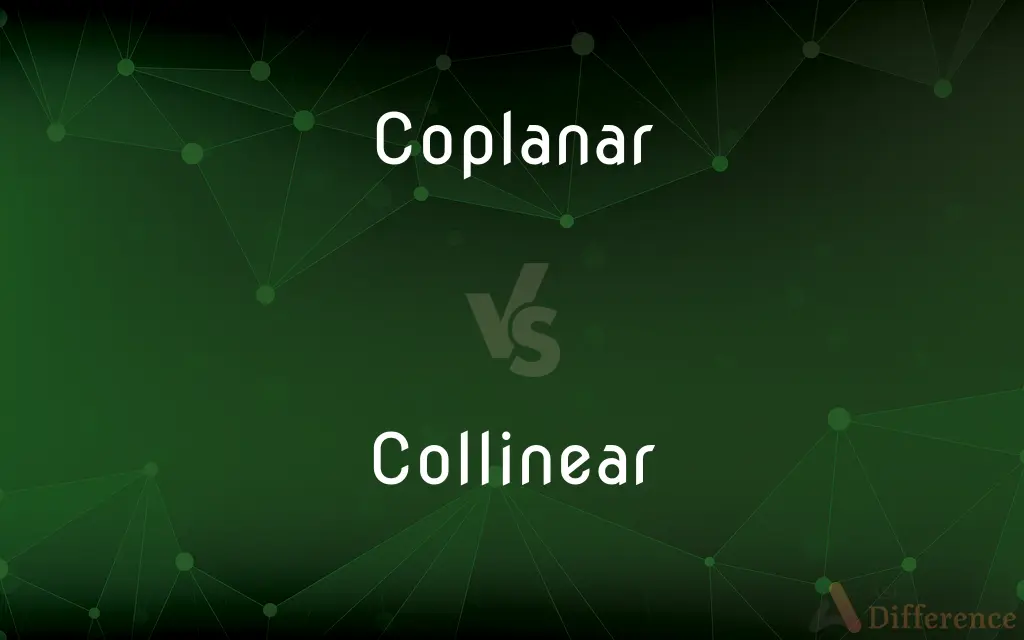Coplanar vs. Collinear — What's the Difference?
By Tayyaba Rehman & Maham Liaqat — Updated on April 17, 2024
Coplanar points lie on the same plane, offering spatial alignment, while collinear points align strictly on a single straight line.

Difference Between Coplanar and Collinear
Table of Contents
ADVERTISEMENT
Key Differences
Coplanar points are defined as points that reside within the same plane, regardless of their arrangement. Whereas collinear points are a subset, where not only do they lie in a single plane, but they must also align on a straight line.
Coplanar can include an unlimited number of points as long as they share a common plane. On the other hand, collinear points are limited by the linear arrangement, meaning they must be positioned along a line.
Coplanar arrangements can be visualized in various geometric shapes and figures spread across a plane. Whereas collinear points are strictly visualized as points on a line segment or a line, limiting their spatial representation to one dimension.
Coplanar points support concepts in two-dimensional geometry, such as polygons and plane sections. Whereas collinear points are critical in understanding line segments, rays, and linear equations.
Coplanar points are studied in the context of planes in three-dimensional space, useful in fields like engineering and architecture. Collinear points, however, find specific applications in one-dimensional analyses, like determining if points lie on the same path or trajectory.
ADVERTISEMENT
Comparison Chart
Definition
Points that lie on the same plane.
Points that lie on the same straight line.
Dimensional Requirement
At least three non-collinear points to define a plane.
At least two points needed to define a line.
Geometric Applications
Useful in defining planes and surfaces.
Essential for defining lines and line segments.
Spatial Flexibility
Allows for varied arrangements within a plane.
Restricted to a straight-line arrangement.
Utility in Mathematics
Crucial in planar geometry and three-dimensional analysis.
Primarily used in linear geometry and calculations.
Compare with Definitions
Coplanar
A term used to describe the arrangement of lines, points, or shapes on a single plane.
In drafting, ensuring elements are coplanar is essential for accuracy.
Collinear
Essential for linear configurations in geometry.
Collinear points on a grid are used to determine slope.
Coplanar
Relevant in discussions involving surfaces and spatial layouts.
All the vertices of a square are coplanar.
Collinear
Used in navigation and mapping to define straight paths.
Collinear landmarks help pilots navigate.
Coplanar
Important in geometric proofs and theorems involving planes.
In architecture, coplanar walls ensure uniformity and structural balance.
Collinear
Reflects a precise alignment along a single dimension.
Engineers use the concept of collinearity to align beams and load paths.
Coplanar
Applies to any number of points as long as they share a common plane.
Designing a coplanar circuit layout helps in reducing interference.
Collinear
Points that lie on the same straight line.
Points X, Y, and Z are collinear if they can be connected without any bends.
Coplanar
Points that exist in the same two-dimensional plane.
Points A, B, and C are coplanar if they can all be covered by a single sheet of paper.
Collinear
Crucial for algorithms in computer graphics and vision.
Detecting collinear points can optimize rendering processes.
Coplanar
Lying or occurring in the same plane. Used of points, lines, or figures.
Collinear
Passing through or lying on the same straight line.
Coplanar
Within the same plane.
Collinear
Containing a common line; coaxial.
Coplanar
Orbiting a central celestial object within the same orbital plane.
Collinear
(geometry) Lying on the same straight line.
Coplanar
Situated in one plane.
Collinear
Coaxial.
Coplanar
Lying in the same plane
Collinear
Lying on the same line
Common Curiosities
What tools are used to verify collinearity in a physical setting?
Tools like straightedges, lasers, and optical collimators can verify the alignment of points along a line.
How does computer software utilize the concept of collinearity?
Software for digital image processing and computer vision often uses collinearity conditions to perform tasks like feature matching and object reconstruction.
What is the simplest example of collinear points?
Three or more points on a ruler are collinear since they align on the straight edge.
How can you determine if three points are coplanar in a three-dimensional space?
Three points are coplanar in three-dimensional space if the volume of the tetrahedron they form with any fourth point (not in their plane) is zero.
Can the concepts of coplanarity and collinearity be applied to vectors?
Yes, vectors are coplanar if they lie in the same plane and collinear if they are scalar multiples of each other.
In which fields are the concepts of coplanarity and collinearity particularly useful?
These concepts are widely used in fields such as geometry, engineering, computer graphics, and robotics.
Can lines be coplanar without being collinear?
Yes, lines can be coplanar if they lie in the same plane but not necessarily collinear unless they intersect along a single line.
Why is understanding collinearity important in satellite geometry?
For satellite geometry, particularly in formations and constellations, understanding collinearity ensures proper alignment and positioning for optimal coverage and communication.
What mathematical conditions define coplanar vectors?
Vectors are coplanar if their scalar triple product is zero, indicating they all lie in a single plane.
How does the concept of collinearity impact statistical analyses?
In statistics, collinearity among variables can complicate models and analyses, leading to unreliable and unstable estimates of regression coefficients.
What is the geometric significance of collinear and coplanar points in polygon constructions?
Collinear points in polygons can simplify or restrict shapes to simpler figures like triangles, while coplanar points ensure the polygon lies flat on a plane.
What are some everyday examples of collinear points?
Examples include street lamps along a road, seats in a theater row, or books aligned on a shelf.
How can architects benefit from understanding coplanar points?
Architects use the concept of coplanarity to design layers and interfaces between different building materials, ensuring structural integrity and visual alignment.
Can the concept of coplanarity be used to solve problems in physics?
Yes, understanding coplanarity is useful in physics for analyzing forces in mechanics, describing motion in planes, and simplifying complex systems into two-dimensional analyses.
What role do collinear and coplanar points play in robotics?
In robotics, these concepts are crucial for tasks like the alignment of robotic arms, path planning, and constructing stable platforms.
Share Your Discovery

Previous Comparison
Fluctuation vs. Variation
Next Comparison
Door vs. PortalAuthor Spotlight
Written by
Tayyaba RehmanTayyaba Rehman is a distinguished writer, currently serving as a primary contributor to askdifference.com. As a researcher in semantics and etymology, Tayyaba's passion for the complexity of languages and their distinctions has found a perfect home on the platform. Tayyaba delves into the intricacies of language, distinguishing between commonly confused words and phrases, thereby providing clarity for readers worldwide.
Co-written by
Maham Liaqat















































